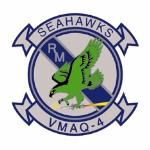
The Northrop GrummanEA-6B Prowler is a twin-engine, four-seat, mid-wing electronic-warfare aircraft derived from the A-6 Intruder airframe. The EA-6A was the initial electronic warfare version of the A-6 used by the United States Marine Corps and United States Navy; it was used during the Vietnam War. Development on the more advanced EA-6B began in 1966. An EA-6B aircrew consisted of one pilot and three Electronic Countermeasures Officers, though it was not uncommon for only two ECMOs to be used on missions. It was capable of carrying and firing anti-radiation missiles (ARMs), such as the AGM-88 HARM.
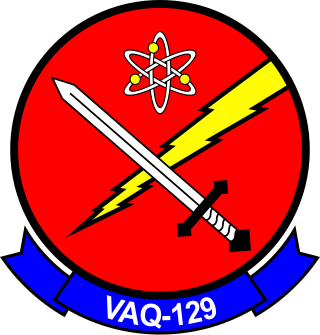
Electronic Attack Squadron 129 (VAQ-129) is the United States Navy's only EA-18G Growler training squadron. Known as the "Vikings", they are a Fleet Replacement Squadron, or FRS, and are charged with training all EA-18G aviators and developing standard operating procedures for the maintenance and operation of the aircraft. The squadron is permanently stationed at Naval Air Station Whidbey Island, in Puget Sound, Washington.
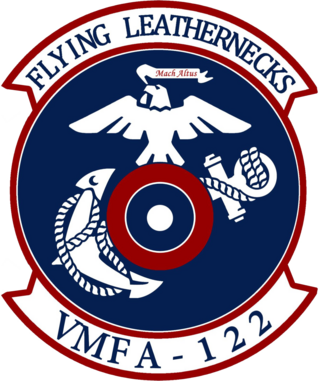
Marine Fighter Attack Squadron 122 (VMFA-122) is a United States Marine Corps fighter attack squadron flying the F-35B Lightning II. The squadron is based out of Marine Corps Air Station Yuma, AZ and falls under the command of Marine Aircraft Group 13 (MAG-13) and the 3rd Marine Aircraft Wing. The squadron nickname is the "Flying Leathernecks," and their traditional radio call sign is "Nikel". On 14 November 2017, VMFA-122 opened a new chapter of their history, transitioning from the McDonnell Douglas F/A-18C Hornet to the Lockheed Martin F-35B Lightning II and moving from MCAS Beaufort and MAG-31, 2nd MAW to MCAS Yuma and MAG-13, 3rd MAW.

Electronic Attack Squadron 135 (VAQ-135), known as the "Black Ravens", is a United States Navy electronic attack squadron that currently operates the EA-18G Growler carrier-based electronic warfare jet aircraft. The squadron is permanently stationed at Naval Air Station Whidbey Island with a radio callsign of "Thunder".

Electromagnetic Attack Squadron ONE FOUR ZERO (VAQ-140) is a US Navy electromagnetic attack squadron. Known as the "Patriots", the squadron operates the EA-18G Growler. The squadron is home ported at NAS Whidbey Island, Washington. They are attached to Carrier Air Wing Seven, and deploy aboard USS George H W Bush. The squadron's radio callsign is "Talon" and are formally recognized as America's Squadron. Their aircrew commonly reference the rallying cry of "Glizzy Roll" in honor of their traditional ready room hot dog roller. Their mascot is their newest aircrew dressing as Evel Knievel.

Electromagnetic Attack Squadron 137 (VAQ-137) also known as the "Rooks", is a United States Navy electromagnetic attack squadron based at Naval Air Station Whidbey Island Washington, flying the Boeing EA-18G Growler. The squadron is attached to Carrier Air Wing 11 (CVW-11), which is currently assigned to USS Theodore Roosevelt (CVN-71). Their radio callsign is "Rook" and their tailcode is "NH" of CVW-11.

Marine Tactical Electronic Warfare Training Squadron 1 (VMAQT-1) was a United States Marine Corps electronic warfare training squadron consisting of EA-6B Prowler jets. The squadron was based at Marine Corps Air Station Cherry Point, North Carolina and fell under the command of Marine Aircraft Group 14 (MAG-14) and the 2nd Marine Aircraft Wing. The VMAQT-1 logo was the Banshee, an Irish mythological figure foretelling death. Its motto was "Tairngreacht Bas," Gaelic for "Death Foretold."

A carrier air wing is an operational naval aviation organization composed of several aircraft squadrons and detachments of various types of fixed-wing and rotary-wing aircraft. Organized, equipped and trained to conduct modern US Navy carrier air operations while embarked aboard aircraft carriers, the various squadrons in an air wing have different but complementary missions, and provide most of the striking power and electronic warfare capabilities of a carrier battle group (CVBG). While the CVBG term is still used by other nations, the CVBG in US parlance is now known as a carrier strike group (CSG).
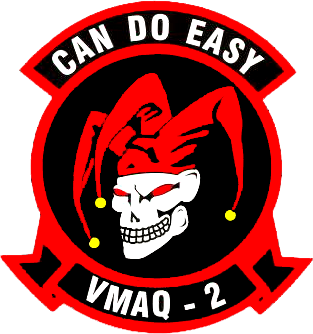
Marine Tactical Electronic Warfare Squadron 2 (VMAQ-2) was a United States Marine Corps electronic warfare squadron in service from 1952 to 2019. It was the last squadron flying the Northrop Grumman EA-6B Prowler.
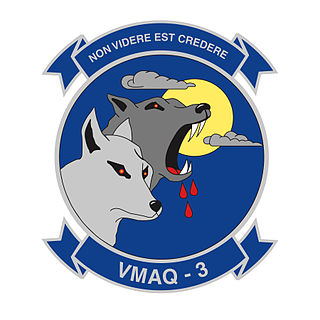
Marine Tactical Electronic Warfare Squadron 3 (VMAQ-3) was one of four Tactical Electronic Warfare Squadrons in the United States Marine Corps. The squadron consisted EA-6B Prowler jets and was tasked with conducting airborne electronic warfare. The squadron was based at Marine Corps Air Station Cherry Point, North Carolina and fell under the command of Marine Aircraft Group 14 (MAG-14) and the 2nd Marine Aircraft Wing. The squadron was decommissioned on 11 May 2018 as the Marine Corps sunsets the EA-6B Prowler.

Marine Fighter Attack Squadron 242 (VMFA-242) is a United States Marine Corps squadron flying F-35B Lightning II STOVL Stealth Fighter. The squadron, known as the "Bats", is based at Marine Corps Air Station Iwakuni, Japan and falls under the command of Marine Aircraft Group 12 (MAG-12) and the 1st Marine Aircraft Wing. The radio callsign is "Profane".

Marine Fighter Attack Squadron 533 (VMFA-533) is a United States Marine Corps F-35B squadron. Also known as the "Hawks", the squadron is based at Marine Corps Air Station Beaufort, South Carolina and falls under the command of Marine Aircraft Group 31 (MAG-31) and the 2nd Marine Aircraft Wing.

Electromagnetic Attack Squadron 142 (VAQ-142), also known as "The Gray Wolves", is an EA-18G Growler squadron of the United States Navy stationed at Naval Air Station Whidbey Island, Oak Harbor, Washington. Their tailcode is AJ and their ATC callsign is "GRIM".

Marine Aviation Logistics Squadron 14 (MALS-14) is an aviation logistics support unit of the United States Marine Corps. They are currently based at Marine Corps Air Station Cherry Point and fall under the command of Marine Aircraft Group 14 (MAG-14) and the 2nd Marine Aircraft Wing.

Marine Tactical Reconnaissance Squadron 3 (VMFP-3) was an aviation unit of the United States Marine Corps active between 1975 and 1990.

Electronic Attack Squadron 134 (VAQ-134) is an electromagnetic warfare squadron of the United States Navy. It is nicknamed "Garudas" and is based at Naval Air Station Whidbey Island, Washington. The squadron is currently equipped with the Boeing EA-18G Growler.
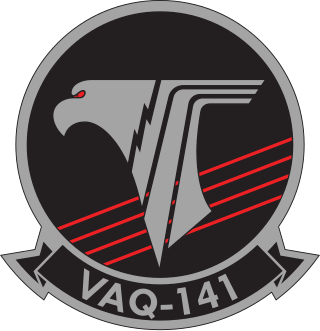
Electromagnetic Attack Squadron 141 (VAQ-141), also known as the "Shadowhawks", is an EA-18G Growler squadron of the United States Navy that is based at Marine Corps Air Station Iwakuni, located in Iwakuni, Yamaguchi, Japan. VAQ-141 falls under the cognizance of Commander, Electromagnetic Attack Wing Pacific (COMVAQWINGPAC) and flies in support of Carrier Air Wing 5 (CVW-5) aboard the Nimitz-class aircraft carrier, USS Ronald Reagan (CVN-76).

Electronic Attack Squadron 138 (VAQ-138), also known as the "Yellow Jackets", is an expeditionary EA-18G Growler squadron of the United States Navy based at Naval Air Station Whidbey Island, Washington.

Marine Composite Reconnaissance Squadron 1 (VMCJ-1) was an aviation squadron of the United States Marine Corps that provided aerial photographic reconnaissance and electronic countermeasures is support of the Fleet Marine Force. The squadron was formed in 1958 with the merger of Marine Composite Squadron 1 (VMC-1) and Marine Photo Reconnaissance 1 (VMJ-1). The squadron's support to the Vietnam War began in 1964 flying off Yankee Station and ended with sorties in support of Operation Frequent Wind during the fall of Saigon. VMCJ-1 was decommissioned in 1975 as the Marine Corps further consolidated its aerial photo reconnaissance assets after the Vietnam War.
